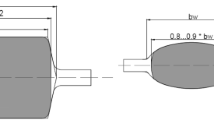Abstract
Research on expanding the product range and minimizing the energy costs at a linear medium-bar mill with three-high roughing stands is discussed. The possibility of controlling the mechanical properties of the product by decreasing the initial rolling temperature is considered. Despite the improvement in mechanical properties, decrease in the initial rolling temperature in the range 900–950°C is accompanied by increase in current load at the primary drive and decrease in dimensional precision of the product.
Similar content being viewed by others
References
Zhuchkov, S.M. and Palamar’, D.G., Non-traditional approaches to the development of rolling mill industry, Lit’e Metall., 2006, no. 2, pp. 53–55.
Rodinkov, S.V., Kriventsov, A.M., Solomichev, N.V., et al., A modern complex for rolling used rails in the rolling of a wide-dimensioned assortment, Chern. Met., 2006, no. 10, pp. 11–17.
Byer Steel, The rebar mill. http://www.byersteelminded.com/The-Rebar-Mill.cfm. Accessed March 1, 2018.
The power of energy efficiency: success stories from the Indian steel re-rolling sector. http://www.in.undp.org/content/india/en/home/ourwork/environmentandenergy/videos/the-power-ofenergy-efficiency-successstories-from-the-indian-steel-rerolling-sector/. Accessed February 25, 2018.
Ilyukovich, B.M., Nekhaev, N.E., and Merkur’ev, S.E., Prokatka i kalibrovka: spravochnik (Rolling and Calibration: Handbook), Dnepropetrovsk: Dnepro-VAL, 2002, vol.1.
Potapova, M.V. and Potapov, M.G., The trends for metallurgical mini-mills development in the Russian Federation, Modern Sci., 2017, no. 10, pp. 11–15.
Tula Metal Rolling Plant (TMPZ). http://tulampz.ru/. Accessed March 3, 2018.
Volga Electrometallurgical Plant (VEMZ). http://www.vemz.org. Accessed February 27, 2018.
Lubenets, A.N., Smirnov, E.N., and Shcherbachev, V.V., Production of ship sections from continuously cast billets, Stal’, 2002, no. 8, pp. 102–106.
Smyrnov, Y.N., Skliar, V.A., Belevitin, V.A., et al., Defect healing in the axial zone of continuous-cast billet, Steel Transl., 2016, vol. 46, no. 5, pp. 325–328.
Minaev, A.A., Nosanev, A.G., Smirnov, E.N., et al., Unit for accelerated cooling of reinforced bars in the line of a 330 mill after deformation, Metallurgist, 1990, vol. 34, no. 1, p.17.
Hensel, A., Spittel, T., Spittel, M., et al., Rationeller Energieeinsatz bei Umformprozessen, Leipzig: Deutscher Verlag für Grundstoffindustrie, 1983.
Lam M.M., Serov A.I., Smirnov E.N., et al., Mastering the production of 40-and 60-mm-diam. grinding balls in hardness classes III and IV at the Donetsk Metal-Rolling Plant, Metallurgist, 2016, vol. 60, nos. 3–4, pp. 440–446.
Smirnov, A.N., Khobta, A.S., Smirnov, E.N., et al., Casting of steel from the tundish of a continuous caster with a sliding gate, Russ. Metall. (Engl. Transl.), 2012, no. 12, pp. 1–5.
Smirnov, A.N., Kuberskii, S.V., Smirnov, E.N., et al., Influence of meniscus fluctuations in the mold on crust formation in slab casting, Steel Transl., 2017, vol. 47, no. 7, pp. 476–482.
Liberman, A.L., Dubrovin, I.V., Talanov, I.I., et al., Minimal drafting of continuously casted billets for high-quality rolled products, Metallurg, 1993, no. 4, pp. 31–34.
Botnikov, S.A., Sovremennyi atlas defektov nepreryvnolitoi zagotovki i prichiny vozniknoveniya proryvov kristallizuyushcheisya korochki metalla (A Modern Atlas of Defects of a Continuously Casted Billet and The Cases of Breakthroughs in a Crystallized Metal Crust), Volgograd, 2011, 2nd ed.
Author information
Authors and Affiliations
Corresponding author
Additional information
Original Russian Text © E.N. Smirnov, A.N. Smirnov, V.A. Sklyar, V.A. Belevitin, S.P. Eron’ko, R.E. Pivovarov, 2018, published in Stal’, 2018, No. 6, pp. 21–26.
About this article
Cite this article
Smirnov, E.N., Smirnov, A.N., Sklyar, V.A. et al. Effects of Decreasing the Initial Rolling Temperature in Three-High Roughing Stands. Steel Transl. 48, 381–387 (2018). https://doi.org/10.3103/S0967091218060104
Received:
Published:
Issue Date:
DOI: https://doi.org/10.3103/S0967091218060104




